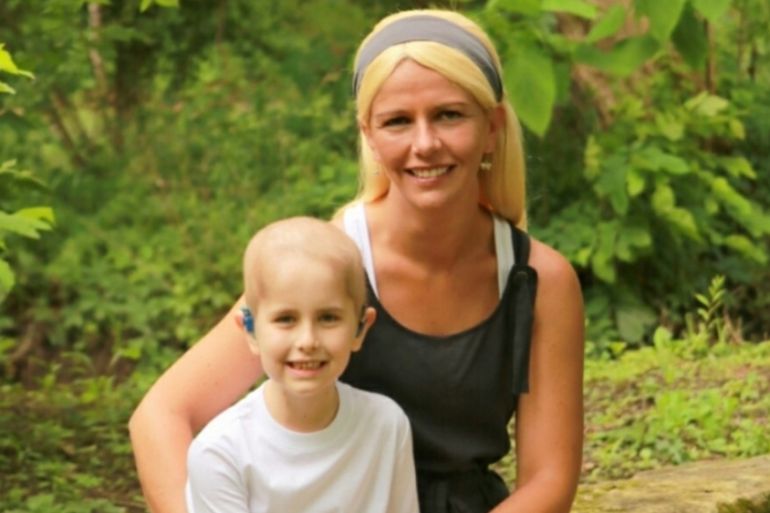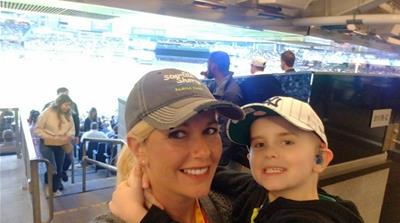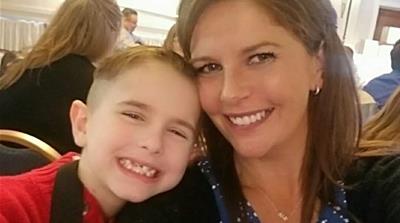Financial ruin: Childhood cancer’s other battle
Nonmedical expenses often overwhelm United States families dealing with childhood cancers.

Heather Vincent lives as modestly as possible. She avoids buying new clothes and making repairs on her old car to save money for medical bills associated with her son’s rare cancer. She tries to anticipate everything she and her son might need to buy en route to New York City, where seven-year-old Jackson sees a paediatric oncologist specialising in central nervous system relapse and neuroblastoma.
“The financial impact it has had on us has been overwhelming, sometimes just as overwhelming as the cancer itself,” Vincent told Al Jazeera.
Keep reading
list of 4 itemsDeadly Sahel heatwave caused by ‘human-induced’ climate change: Study
Woman, seeking loan, wheels corpse into Brazilian bank
UK set to ban tobacco sales for a ‘smoke-free’ generation. Will it work?
Vincent estimates that since Jackson was diagnosed with stage four cancer in October 2015, her family has spent $25,000 on out-of-pocket, nonmedical expenses. Those costs include occasional weekly trips between their home in Cuyahoga Falls, Ohio, and Memorial Sloan Kettering Cancer Center, 725km (450 miles) away in Manhattan.
Thirty percent of children diagnosed with cancer in the United States must travel at least 96 kilometres (60 miles) to reach the closest paediatric oncologist, found a 2013 study by the University of Minnesota, the Children’s Oncology Group and the non-profit Compass to Care.

But in addition to the enormous physical and emotional toll cancer takes on children and their families, there is also a financial one. The specialised treatment paediatric cancer requires – as well as the long distances some families must travel to access it – magnifies both medical and out-of-pocket expenses.
Paediatric cancer hospitalisations cost almost five times as much as hospitalisations for other paediatric conditions in 2009, amounting to $40,400 over an average stay of 12 days, according to a brief published by the US Agency for Healthcare Research and Quality.
“As adults, we can sit in waiting rooms, have blood drawn and process all the medical treatments that we are thrust into,” Jeri Wilson, the executive director of the Pediatric Cancer Research Foundation, told Al Jazeera.
For children, on the other hand, the process requires costly modifications: social workers and special treatment to help a child through the “scary and sometimes painful process” of treatment, says Wilson.
“Hospitals spend much more time and money on children than adults to ease the experience not only for the child, but for the entire family,” says Wilson.
‘The hidden cost of childhood cancer’
Cancer is the second-leading cause of death for children in the US, according to the American Cancer Society (ACS), which estimates that 11,050 children under the age of 15 will be diagnosed with cancer in 2020.
Treating those young patients is different than treating adults, according to the ACS. First, the types of cancers that children develop are different and generally less linked to environmental or lifestyle factors.

Children respond better to treatment than adults, on average, but can face more long-term side effects. Because of this, children with cancer in the US are generally treated by specialised medical teams at paediatric cancer centres, which means that in addition to medical bills, many families – like Jackson’s – also face high travel costs.
“More than once, I haven’t known how I was going to pay for something associated with Jackson’s medical costs or just the cost of basic living,” Vincent said.
Michelle Ernsdorff-May founded Compass to Care, which helps families cover those travel costs, after surviving childhood cancer herself.
When she was 14 months old, Ernsdorff-May was diagnosed with kidney cancer and sent for treatment to the Mayo Clinic in Rochester, Minnesota, more than 322 kilometres (200 miles) away from her home in Dubuque, Iowa. For the year and a half that she underwent treatment, her parents struggled to take time off from work, pay medical bills, and afford gas, hotels and meals near the hospital.
“On one occasion, my father hitchhiked home because he didn’t have money to pay for a car rental or bus ticket when I had to be admitted unexpectedly,” Ernsdorff-May told Al Jazeera. “The experience of my father taking the first steps of a 200-mile trip – hoping someone safe would pick him up as I was fighting for my life in the hospital – was all so devastating to hear, yet not a unique story.”
Unlike medical bills – which insurance can help cover – travel costs such as hotels, flights, gas, parking and tolls come directly out of families’ pockets and are usually not reimbursable.
“Some parents have reported skipping taking their child to treatment when they did not have money in the bank to cover these expenses,” Ernsdorff-May said. “Because so many children travel to access cancer treatment, these expenses are often considered the hidden cost of childhood cancer. Yet they are the ones that can truly stand in the way of a child’s cancer cure.”
Loss of income
Another obstacle for parents is taking time off from work to take children to treatments or stay home with them when their immune systems are too weak for them to go to school. Vincent, who used to work at a merchant processing company, said she has been unable to find a job since Jackson’s cancer diagnosis in 2015, another major source of financial stress.
Because so many children travel to access cancer treatment, these expenses are often considered the hidden cost of childhood cancer.
“Finding a new job with the flexibility that I would need to still be able to travel for all Jackson’s treatments -[and] still take him to all his weekly local appointments when we are home and also stay home with him when he is unable to go to school – has unfortunately proved impossible thus far,” she said.
The federal Family Medical Leave Act (FMLA) allows eligible employees to take job-protected leave to care for a sick family member, including a child. But it only guarantees 12 workweeks of leave over the course of a year, and it is not paid. Affording childcare for other children can also be a challenge.
“Most children with cancer are typically treated anywhere between a few months to up to three years, making the FMLA inadequate,” Ernsdorff-May said. “The reduction in household income comes at a time when the family’s expenses are rising, and the longer a child is in treatment, the more financially devastating the situation can become.”
‘The newness wears off; the funds run out’
Survival rates for childhood cancers have been rising over the past four decades, according to the ACS, and 84 percent of children with cancer now survive five years or more.
But that also means families must find the money to pay for years of treatments and travel, as well as the lifelong follow-up care and monitoring that childhood cancer survivors need. Vincent said that when she and Jackson see his doctors today, they stay at Ronald McDonald House New York, a charity that provides temporary housing to paediatric cancer patients and their families.
Vincent said she felt “incredibly grateful” when family and friends pitched in and organised fundraisers to help. But four and a half years into Jackson’s cancer treatments, Vincent said, “the newness wears off, the help stops coming in, and the funds run out, but you’re still facing all the same costs as you were since day one.”
“You feel bad reminding everyone that you are still struggling to be able to afford the costs associated with just trying to save your child’s life, so that’s when it becomes the hardest financially,” Vincent said. “It’s really stressful and emotionally overwhelming at times, trying to figure out how you are going to afford the costs for the next treatments.”